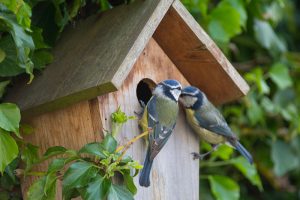So many species of garden birds fly overhead and many of them stop at our bird tables and feeding stations for a bite to eat before continuing their journey.
Once you have mastered the art of encouraging them to visit, usually by enticing them with their favourite foods, wouldn’t it be nice to invite them to stay for a while?
Once you know which birds use nesting boxes and any preferences they might have, you are well on your way to seeing a mating couple hatch and raise their brood.
Many species of birds will choose to raise their young in a nesting box, they are usually ‘cavity nesters’ in the wild. Various members of the tit family, robins, sparrows, and wagtails often frequent bird boxes.
As spring approaches, you might find birds showing an interest in your box if you follow a few criteria.
The size of the box and particularly the entrance hole are important factors, as are the positioning and height of its placement.

Table of Contents
Boxes with Small Holes
As you might expect, smaller birds look for boxes with a little entrance hole. This is mostly to prevent predators from reaching in to steal their eggs or young.
Blue tit – Prefer a box 2-4 metres up a tree or a wall with a clear flight path. The doorway need only be 25mm diameter. They will be found between March and June.
Great tit – Their hole needs to be slightly bigger, 28mm, but similarly positioned to the blue tit. Expect them to use it from March – July.
Coal tit – Between March and July Coal tits will gladly utilise a box above a meter from the ground. They need a clear flight path for smooth landings.
Pied Flycatcher – prefers a box with a 28mm hole at between 2-4m up a tree. They nest between April and July.
House Sparrow – They require slightly bigger entrance holes of 32mm and will inhabit the nest between March right the way through to August. They are less picky where the box is and will move in most places. As they in loose colonies, they may use multiple nesting boxes simultaneously. In the eaves of buildings is the perfect place for a nesting box.
Nut Hatch – Position a nesting box at least 3m above the ground to attract a nuthatch; ensure it has a clear flight path that isn’t obscured by branches or trees. The entrance hole should be 32mm to encourage her to move in and stay from April – June.
Bird Boxes with Large Holes
Boxes with larger openings encourage starlings, (45mm) and if you’re really lucky, you might get a little owl to move in. He would need a 70mm doorway and would only stay from April to May.
Some birds, such as the pied wagtail and the spotted flycatcher, prefer an open-fronted box. Our friend the robin also does, but he likes to be hidden, away from the prying eyes of predators.
Wrens are a different kettle of fish altogether! The male is a very industrious bird that chooses to build multiple nests all within proximity. He then invites the female to choose her favourite, in an attempt to win her heart. Replicating this system is one way to attract a wren to your nesting box. I admit to trying this, securing multiple boxes in one tree, sadly, to no avail. Yet.
Where to Place a Nesting Box
Once you are sure of the height, consider placing a box between the north and east directions. This will keep it safe from the strongest sunlight and the wettest winds. If trees or buildings are protecting it, this won’t be a concern.
Try to tilt the box slightly forward, enabling any rain to naturally run away from the entrance.
Finally
No matter how welcoming you make your garden, some birds will refuse to use your nesting boxes; goldfinches are a prime example.
For those birds, we recommend leaving them plenty of food and water. If there is a ready supply of nesting materials they just might be persuaded to build their own nest in your garden.

Walter. We have one small nesting box. My Father. Made it maybe 20 years before his death in 2017. I think he has left a legacy. The box has a small 25mm hole and is now being “furnished” by a small cocked tail brown; orange/yellow chested bird. Maybe a wren?
It is a delight. Any tips?
How wonderful, Laurence!
Sounds like it could be a Wren, keep an eye and ear out. If the chicks hatch you will see plenty of flying back and forth to feed! Put some food out near by if you can so that they don’t struggle too much to find food.
Perhaps then give it a little clean out once the Autumn/Winter time comes ready for next spring and hopefully it will get used year after year!